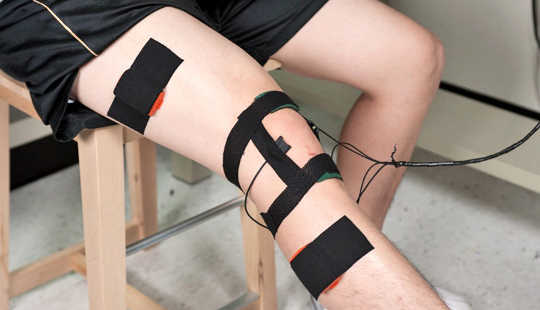 MEMS microphones and piezoelectric strips pick up sounds of a bending and extending knee. (Credit: Georgia Tech)
MEMS microphones and piezoelectric strips pick up sounds of a bending and extending knee. (Credit: Georgia Tech)
"It's a little bit like some kind of Halloween stuff happening," says Omer Inan. "You're listening to your bones rubbing on each other, or maybe cartilage."
Engineers are developing an acoustic knee band equipped with microphones and vibration sensors that can listen and measure sounds inside the joint—and could lead to a way to help orthopedic specialists assess damage after an injury and track recovery progress.
Omer Inan, assistant professor of electrical and computer engineering at Georgia Tech, has been thinking about developing such a device for some time. He’s a former discus thrower at Stanford University and spent years whirling around like a tornado, which knees aren’t built for, so he has suffered quite a bit of knee pain himself.
“I would always feel like my knee was creaking or popping more if I was putting more stress on it,” he says.
When he heard the first recordings of crackly grinding in early experiments, Inan was delighted. “It was a lot louder than expected and a lot clearer,” That meant instant progress. “It’s a little bit like some kind of Halloween stuff happening. You’re listening to your bones rubbing on each other, or maybe cartilage.” Doctors call the joint cracking “crepitus.”
Some 100 years ago, doctors thought the racket might contain a message and listened to it with stethoscopes. Inan hopes that in the future, medical research will build on the acoustical sensing technology his group is designing, and eventually decode the sound into useful patterns.
For now, researchers are graphing out the recorded audio and matching it to the joint’s range of motion to see where exactly in the leg’s extending and bending the knee creates creaks and pops. The result has peaks and squiggles that resemble an electrocardiogram or other physiological signal.
The acoustic pattern an injured knee produces is markedly different from that of an intact knee. “It’s more erratic,” Inan says. “A healthy knee produces a more consistent pattern of noises.”
Soldiers and repeat injuries
If paired with medical research, the acoustic device could lead to inexpensive, wearable monitors, which could benefit athletes who have overburdened their knees, and elderly patients who have slipped and fallen. DARPA, which funded the work, wants to cut down on repeat battlefield knee injuries and help get soldiers back to duty safely.
“What most people don’t know is that musculoskeletal injuries of the knees and ankles are among the top reasons for discharge for active duty service members,” Inan says. Backpacks weighing up to 100 pounds press down on soldiers, as they march for dozens of miles over tricky terrain, climb over obstacles on battlefields, and crouch in cramped spots for hours.
Even without a fall or contortion, a soldier can land in surgery then in rehab. The problem may seem fixed months later, but too often it’s not, and too often that’s because of re-injury.
After surgery and therapy, that knee may feel like new, but when an overeager soldier jumps back onto it, weaknesses from the injury kick in. As a result, re-injuries are 10 times more frequent than initial ones.
An inexpensive wearable device could give soldiers and clinicians in the future feedback on convalescing knees to help them avoid major re-injury by refraining from heavy workloads when needed.
That could benefit service members in the long run, too. Joint injuries compound over time, setting retired service members up for pain and loss of mobility long into civilian life. “You can have cases of early osteoarthritis,” Inan says.
Extraneous noises
But at this point, Inan’s mission is to record the sounds in potentially useful quality which has posed some challenges. The knee joint is surrounded by fluid, which blunts sound waves that are exiting the joint for the skin. Also, when a patient moves around, it causes extraneous noises that can drown out useful sounds.
“The fact that the measurement has to occur by definition during movement is a challenge, because you can’t just tell the person to be still and avoid motion artifacts,” he says.
To develop the acoustic device, researchers combined microphones with piezoelectric film, a hypersensitive vibration sensor that collects the best sound, but is very sensitive to interference. The microphones placed against the skin make for an ample backup and for a more practical device.
The knee monitor also takes advantage of a technical advancement common in smart phones. Micro-electromechanical systems microphones, or MEMS, integrate better with current technology than microphones based on previous technologies. That also makes the microphones downright cheap—only 50 cents to a dollar.
The DARPA Biological Technologies Office supported the work. The paper is published online in the journal IEEE Transactions in Biomedical Engineering.
Source: Georgia Institute of Technology
Related Books
at InnerSelf Market and Amazon
























